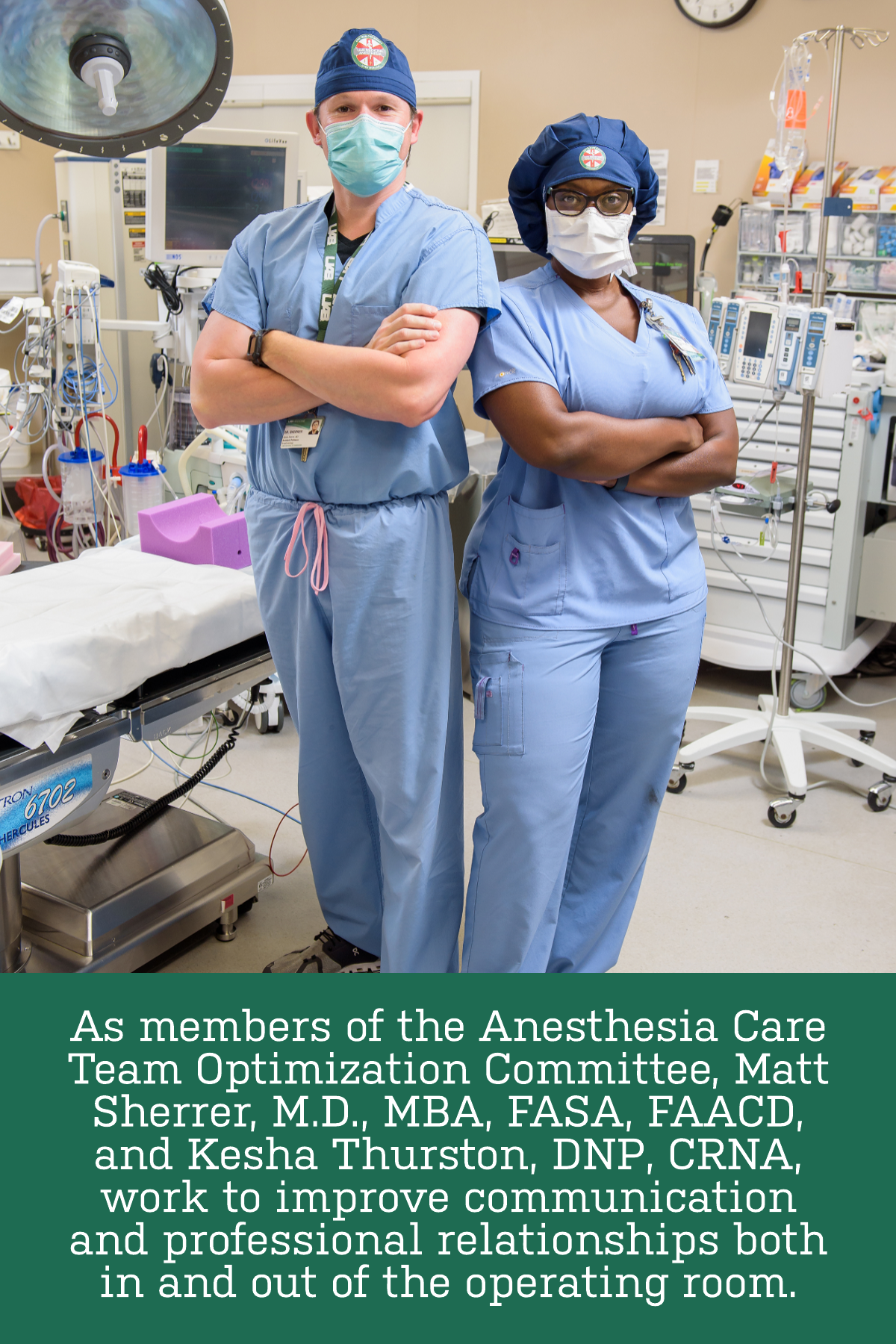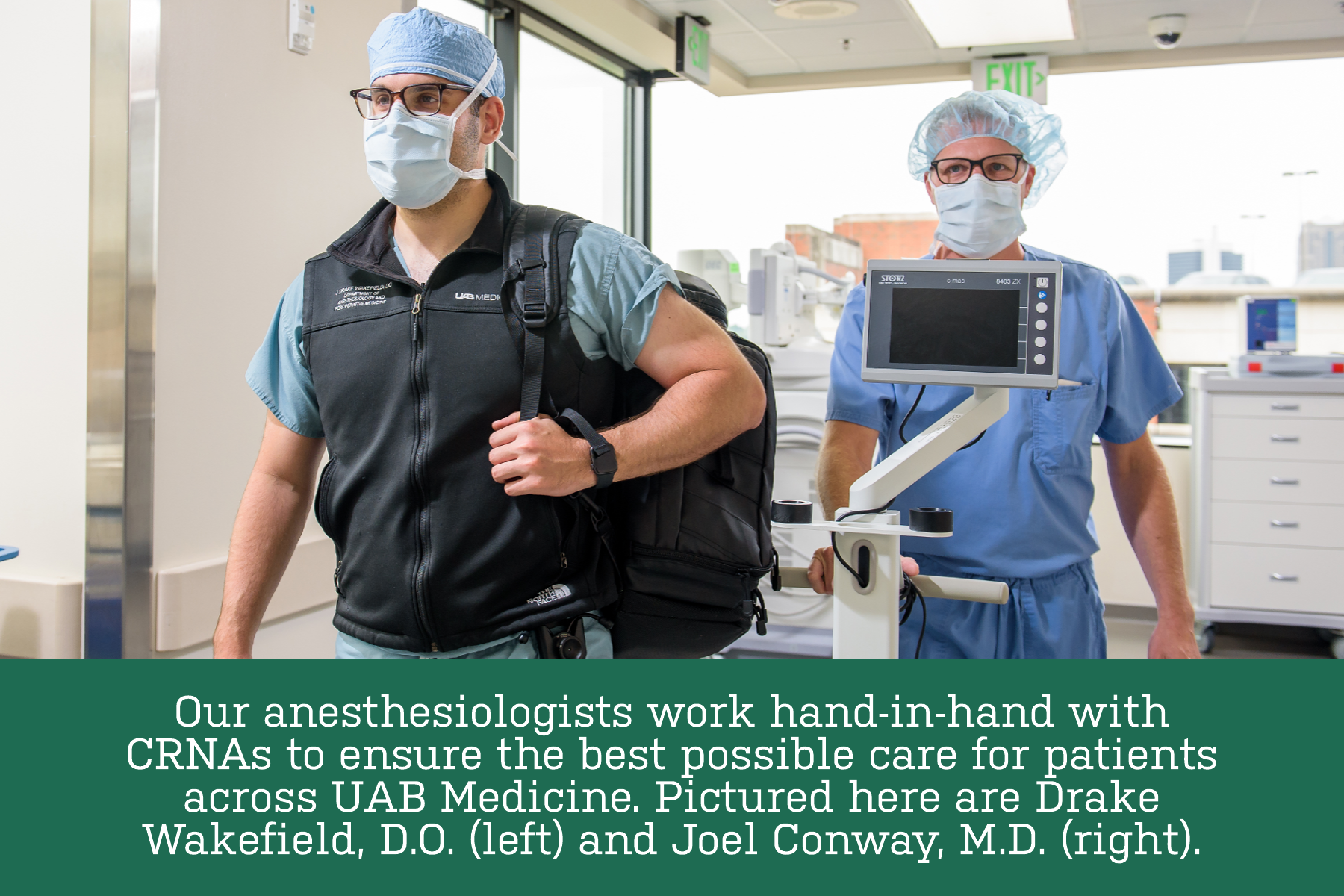 Communication is key to excellent patient care. If lines of communication break down, it takes hard work and determination to rectify the issues and mend professional relationships. Such was the case among our anesthesia care teams; and when the issues were identified, members of our department and a devoted group of CRNAs sprang into action creating the Anesthesia Care Team Optimization Committee (ACTOC) in 2019.
Communication is key to excellent patient care. If lines of communication break down, it takes hard work and determination to rectify the issues and mend professional relationships. Such was the case among our anesthesia care teams; and when the issues were identified, members of our department and a devoted group of CRNAs sprang into action creating the Anesthesia Care Team Optimization Committee (ACTOC) in 2019.
“The relationship between our anesthesiologists and CRNAs was really bad. It was a really cold relationship,” says Matt Sherrer, M.D., MBA, FASA, FAACD. “But because we were honest enough to admit there was a problem, and because we cared enough to fix it, we were able to come together through ACTOC and make real improvements.”
Under the guidance of Martha Anne Rich, Ph.D., a consulting psychologist, ACTOC set out in 2021 with the goal of creating taskforces to focus on areas to address and make changes to that were both attainable and sustainable. From this plan, the teamwork, education, clinical, and scholarship taskforces were formed.
“ACTOC has become a space where we safely explore our anesthesia care teams in a group that has strong trust, professional respect, and friendship,” says Stacy Wade, M.D., ACTOC member. “The taskforces are built to encourage this mindset and provide fulfilling clinical engagement opportunities.”
The teamwork taskforce – led by Sherrer and Andy Morris, BSN, MSN, CRNA – set out to create socialization opportunities between physician and CRNA colleagues. These are playing out in many scenarios, including journal clubs to discuss academic articles and simple Q&A sessions between care team members who don’t know each other. “This doesn’t have to be a tremendously complicated or academic exercise. Let’s sit and talk and get to know each other,” Sherrer says. “It doesn’t take long to find out that we work with some really amazing people.”
Collaboration sets the tone for the education taskforce. “The ability to partner with anesthesiologists on the front end will lead to lasting changes on the back end,” says Kesha Thurston, DNP, CRNA. “It will improve processes for our patients and create a stronger anesthesia team.” This group, led by Paul Piennette, M.D., and Thurston, is looking forward to holding joint journal clubs with the teamwork taskforce and integrating CRNAs into the department’s Continuous Quality Improvement (CQI) conferences. They are also working with the UAB Office of Interprofessional Simulation for Innovative Clinical Practice to begin PIV/arterial line simulation.
 Perry Smith, M.D., and Gary Boutwell, DNP, CRNA, lead the clinical taskforce. Their team has begun to address communication deficits that affect an anesthesia care team’s performance in patient safety as well as job satisfaction. “We have a great opportunity to optimize how anesthesia care is delivered by UAB Medicine,” Boutwell says. “We have an even greater opportunity to be the national standard for collegiality and professionalism by sharing our work through the physicians and healthcare providers who will eventually move on to other healthcare centers and communities.” In addition, the taskforce is creating a standardized checklist for the operating room, identifying what must be discussed preoperatively, intraoperatively, and early postoperatively by members of the care team.
Perry Smith, M.D., and Gary Boutwell, DNP, CRNA, lead the clinical taskforce. Their team has begun to address communication deficits that affect an anesthesia care team’s performance in patient safety as well as job satisfaction. “We have a great opportunity to optimize how anesthesia care is delivered by UAB Medicine,” Boutwell says. “We have an even greater opportunity to be the national standard for collegiality and professionalism by sharing our work through the physicians and healthcare providers who will eventually move on to other healthcare centers and communities.” In addition, the taskforce is creating a standardized checklist for the operating room, identifying what must be discussed preoperatively, intraoperatively, and early postoperatively by members of the care team.
The scholarship taskforce rounds out the teams and is led by Dan Berkowitz, MB BCh, and Melissa Ramsey, CRNA. Early on, this taskforce spent time researching and discussing what value it could bring to ACTOC. They determined it would be most beneficial to document the ACTOC process “in hopes of publishing the accomplishments of all of the ACTOC taskforces to improve relations amongst other anesthesia care teams throughout the country,” Ramsey says.
In a short amount of time, ACTOC has begun positioning the department and our care teams to be among the best in the nation – setting high standards for other academic medical centers to learn from and replicate. “Realizing that we all have the same goals and motivations – a fulfilling work environment where we take great care of our patients and maximize each team member’s potential – really reframed my perspective,” Sherrer says. “I would hope that we all learn to focus far less on ‘me’ and far more on ‘we’.”